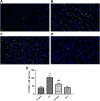Protective effect of quercetin on cadmium-induced renal apoptosis through cyt-c/caspase-9/caspase-3 signaling pathway
- PMID: 36052148
- PMCID: PMC9425064
- DOI: 10.3389/fphar.2022.990993
Protective effect of quercetin on cadmium-induced renal apoptosis through cyt-c/caspase-9/caspase-3 signaling pathway
Abstract
Cadmium (Cd), a heavy metal, has harmful effects on animal and human health, and it can also obviously induce cell apoptosis. Quercetin (Que) is a flavonoid compound with antioxidant and other biological activities. To investigate the protective effect of Que on Cd-induced renal apoptosis in rats. 24 male SD rats were randomly divided into four groups. They were treated as follows: control group was administered orally with normal saline (10 ml/kg); Cd group was injected with 2 mg/kg CdCl2 intraperitoneally; Cd + Que group was injected with 2 mg/kg CdCl2 and intragastric administration of Que (100 mg/kg); Que group was administered orally with Que (100 mg/kg). The experimental results showed that the body weight of Cd-exposed rats significantly decreased and the kidney coefficient increased. In addition, Cd significantly increased the contents of Blood Urea Nitrogen, Creatinine and Uric acid. Cd also increased the glutathione and malondialdehyde contents in renal tissues. The pathological section showed that Cd can cause pathological damages such as narrow lumen and renal interstitial congestion. Cd-induced apoptosis of kidney, which could activate the mRNA and protein expression levels of Cyt-c, Caspase-9 and Caspase-3 were significantly increased. Conversely, Que significantly reduces kidney damage caused by Cd. Kidney pathological damage was alleviated by Que. Que inhibited Cd-induced apoptosis and decreased Cyt-c, Caspase-9 and Caspase-3 proteins and mRNA expression levels. To sum up, Cd can induce kidney injury and apoptosis of renal cells, while Que can reduce Cd-induced kidney damage by reducing oxidative stress and inhibiting apoptosis. These results provide a theoretical basis for the clinical application of Que in the prevention and treatment of cadmium poisoning.
Keywords: apoptosis; cadmium; kidney injury; oxidative stress; quercetin.
Copyright © 2022 Huang, Ding, Ye, Wang, Yu, Yan, Liu and Wang.
Conflict of interest statement
The authors declare that the research was conducted in the absence of any commercial or financial relationships that could be construed as a potential conflict of interest.
Figures







Similar articles
-
Protective effect of quercetin on cadmium-induced kidney apoptosis in rats based on PERK signaling pathway.J Trace Elem Med Biol. 2024 Mar;82:127355. doi: 10.1016/j.jtemb.2023.127355. Epub 2023 Dec 6. J Trace Elem Med Biol. 2024. PMID: 38071864
-
Roles of Cyt-c/Caspase-9/Caspase-3/Bax/Bcl-2 pathway in Cd-induced testicular injury in rats and the protective effect of quercetin.Toxicon. 2024 Jan;237:107561. doi: 10.1016/j.toxicon.2023.107561. Epub 2023 Dec 12. Toxicon. 2024. PMID: 38092195
-
Quercetin attenuates cadmium-induced hepatotoxicity by suppressing oxidative stress and apoptosis in rat.J Trace Elem Med Biol. 2024 Dec;86:127554. doi: 10.1016/j.jtemb.2024.127554. Epub 2024 Oct 18. J Trace Elem Med Biol. 2024. PMID: 39427560
-
Role of endoplasmic reticulum stress in cadmium-induced hepatocyte apoptosis and the protective effect of quercetin.Ecotoxicol Environ Saf. 2022 Aug;241:113772. doi: 10.1016/j.ecoenv.2022.113772. Epub 2022 Jun 14. Ecotoxicol Environ Saf. 2022. PMID: 35714484
-
Protective effect of quercetin on rat testes against cadmium toxicity by alleviating oxidative stress and autophagy.Environ Sci Pollut Res Int. 2020 Jul;27(20):25278-25286. doi: 10.1007/s11356-020-08947-2. Epub 2020 Apr 28. Environ Sci Pollut Res Int. 2020. PMID: 32347499
Cited by
-
Astragaloside IV attenuates cadmium induced nephrotoxicity in rats by activating Nrf2.Sci Rep. 2025 Jan 15;15(1):2028. doi: 10.1038/s41598-025-86312-4. Sci Rep. 2025. PMID: 39815001 Free PMC article.
-
Quercetin protects cadmium-induced renal injuries in mice by inhibiting cell pyroptosis.Front Vet Sci. 2023 Nov 16;10:1319857. doi: 10.3389/fvets.2023.1319857. eCollection 2023. Front Vet Sci. 2023. PMID: 38033639 Free PMC article.
-
Quercetin Alleviates Toxicity Induced by High Levels of Copper in Porcine Follicular Granulosa Cells by Scavenging Reactive Oxygen Species and Improving Mitochondrial Function.Animals (Basel). 2023 Aug 29;13(17):2745. doi: 10.3390/ani13172745. Animals (Basel). 2023. PMID: 37685009 Free PMC article.
-
Protective effect of naringenin on cadmium chloride-induced renal injury via alleviating oxidative stress, endoplasmic reticulum stress, and autophagy in chickens.Front Pharmacol. 2024 Jul 12;15:1440877. doi: 10.3389/fphar.2024.1440877. eCollection 2024. Front Pharmacol. 2024. PMID: 39070780 Free PMC article.
-
Pharmacological Activity of Flavonoid Quercetin and Its Therapeutic Potential in Testicular Injury.Nutrients. 2023 May 8;15(9):2231. doi: 10.3390/nu15092231. Nutrients. 2023. PMID: 37432408 Free PMC article. Review.
References
-
- Carrasco-Torres G., Monroy-Ramírez H. C., Martínez-Guerra A. A., Baltiérrez-Hoyos R., Romero-Tlalolini M., Villa-Treviño S., et al. (2017). Quercetin reverses rat liver preneoplastic lesions induced by chemical carcinogenesis. Oxid. Med. Cell. Longev. 2017, 4674918. 10.1155/2017/4674918 - DOI - PMC - PubMed
-
- Choe J. Y., Park K. Y., Kim S. K. (2015). Oxidative stress by monosodium urate crystals promotes renal cell apoptosis through mitochondrial caspase-dependent pathway in human embryonic kidney 293 cells: Mechanism for urate-induced nephropathy. Apoptosis 20 (1), 38–49. 10.1007/s10495-014-1057-1 - DOI - PubMed
LinkOut - more resources
Full Text Sources
Research Materials

